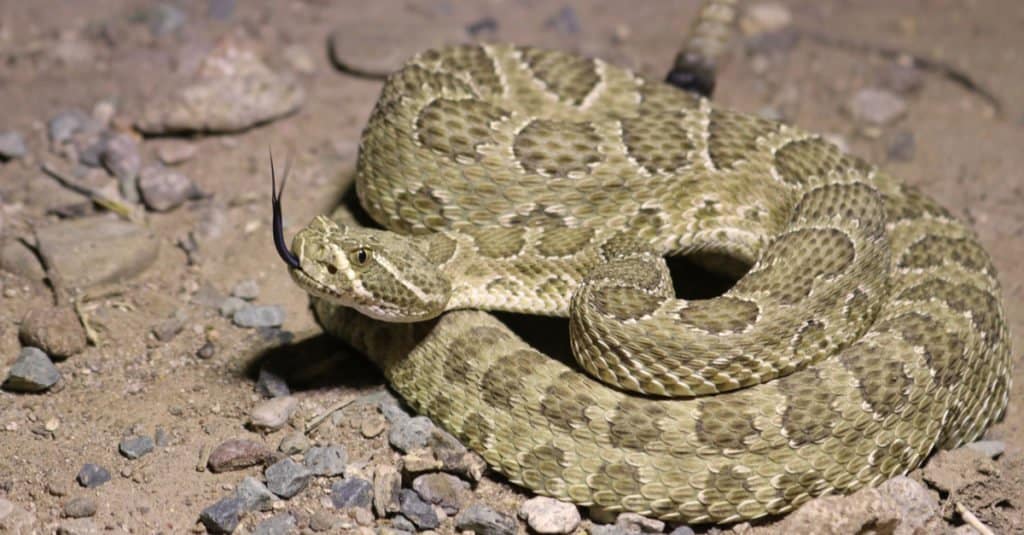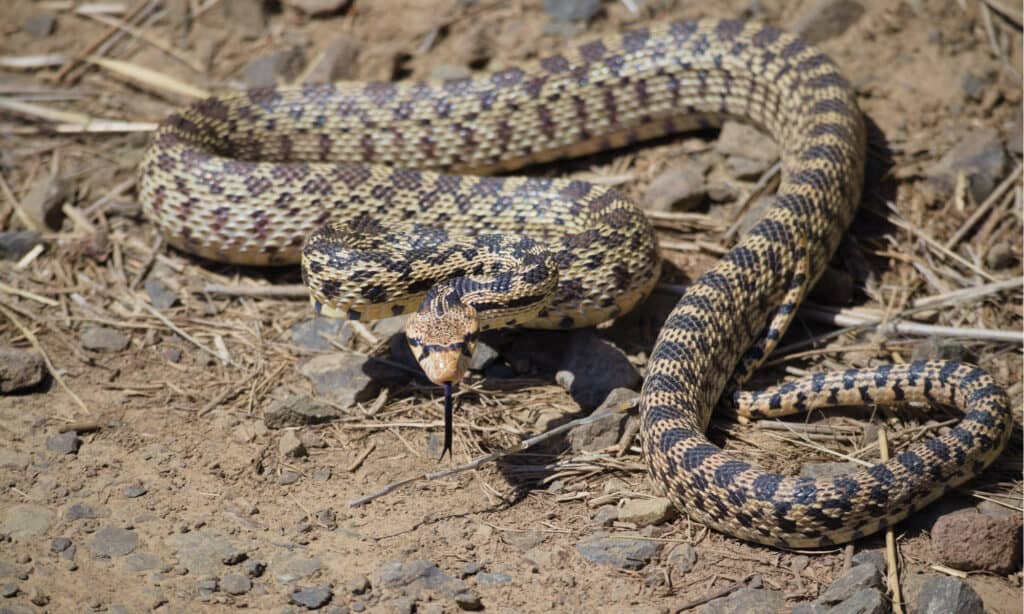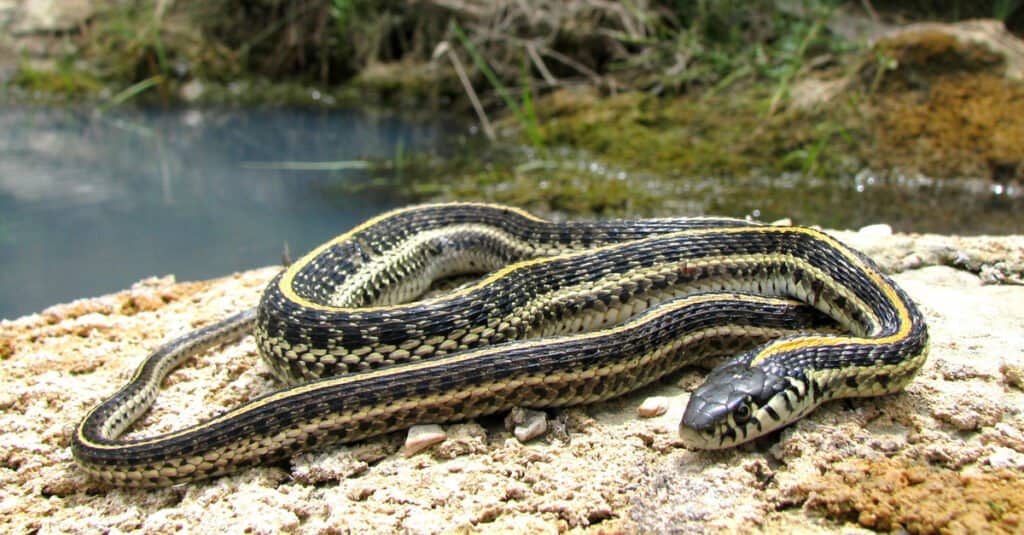Discover North Dakota’s Only Rattlesnake Species
#mobileSnakeQuizControls { overflow: hidden; text-overflow: ellipsis; white-space: nowrap; }
@media (min-width: 481px) {
.mobile-top-content {
display: none;
}
}
#mobileTopContentCTACarouselControls { overflow: hidden; text-overflow: ellipsis; white-space: nowrap; }
.mobile-top-content .more { color: #fff; }
.mobile-top-content a { color: #fff; text-decoration: underline; }
.mobile-top-content a:hover { color: #fff; text-decoration: underline; }
@media (max-width: 480px) {
.mobile-top-content {
background-color: #06a10b;
color: #fff;
text-align: center;
/*height: 60px;
padding-top:5px;*/
font-size:80%;
/* display: block; */
margin: 0px -30px;
}
}
North Dakota is one of the least populous states in the United States, with a large regions of natural wildlife areas. There are also many animals in North Dakota, from large animals like bison and mountain lions to small creatures like beavers and prairie dogs. Amid the variety of wildlife that North Dakota has to offer, however, there are not very many snakes. In fact, there are only 8 different species of snake living in North Dakota. Only one type of snake here is venomous. Take a look at North Dakota’s only rattlesnake species!
Prairie Rattlesnake

The prairie rattlesnake is the only venomous snake found in North Dakota. This snake lives in the southwestern regions of the state. Although occasionally they may travel north, prairie rattlesnakes primarily live on the south side of the Missouri River. These snakes have one of the largest ranges in the United States, and can be found throughout the Great Plains area as well as some parts of Canada and Mexico. Because of this, prairie rattlesnakes are also called “Western Rattlesnakes” or “Great Plains Rattlesnakes.” These snakes can live up to 16-20 years in the wild.
These snakes prefer grassy, woody, and sagebrush areas, and often rest in rock crevices, caves, and burrows of mammals. During the winter prairie rattlesnakes brumate in crevices or in prairie dog burrows with several other snakes. Brumation is like hibernation, except snakes do not sleep through the winter. Instead, they brumate, reducing their activity to a very bare minimum to conserve energy when it’s too cold. When the weather warms up in the spring, prairie rattlesnakes move out of their burrows and begin hunting for food and mating during the day. When summertime gets too hot for these snakes, they rest in shady areas and rock crevices and hunt in the evenings or at night.
button.pulse {
transform: scale(1); animation: pulse 2s infinite;
box-shadow: 0 0 0 0 rgba(11, 247, 25, 1);
}
@keyframes pulse {
0% { transform: scale(0.90); box-shadow: 0 0 0 0 rgba(11, 247, 25, 0.5); }
60% { transform: scale(1); box-shadow: 0 0 0 15px rgba(11, 247, 25, 0); }
100% { transform: scale(0.90); box-shadow: 0 0 0 0 rgba(11, 247, 25, 0); }
}
Appearance

Prairie rattlesnakes have heavy bodies that are typically olive green, greenish-gray, greenish-brown, brown, red, or yellow in color. These snakes are pit vipers with heat-sensing “pits” on their faces between their eyes and nostrils. They also have large, diamond or triangular-shaped heads and thin necks. Prairie rattlesnakes are usually between 35-45 inches in length. There are dark oval blotches outlined in white along their backs that transition into dark rings on their tails just before the rattle.
Baby rattlesnakes, however, are born without rattles. Each time these snakes shed their skin, they grow an additional keratin segment on the end of their tails that eventually forms a rattle. After 2-3 sheds, this rattle can make sound when the snake vibrates its tail. Some people try to guess the snake’s age by how many segments there are in its rattle. This estimate is inaccurate, however, since snakes shed 1-3 times a year, and their rattles can break off.
Behavior

Nina B/Shutterstock.com
Prairie rattlesnakes are venomous and can be dangerous. These snakes will usually issue a warning by rattling their tails, but this is not always the case. In addition, they can strike up to 2/3 of their body length. These snakes can control the amount of venom they inject when biting, and often use “dry bites” without venom. However, their venom has both neurotoxins and hemotoxins that are deadly. This toxic combination kills the snake’s prey and destroys tissue, which helps the snake with digestion. Prairie rattlesnakes are ambush predators and eat mice, gophers, prairie dogs, small birds. Occasionally they also eat lizards and amphibians.
Other Snakes in North Dakota
In addition to the prairie rattlesnake, there are 7 other snake species living in North Dakota. Some snakes, like the plains hognose snake and the bullsnake, look a lot like the prairie rattlesnake. Other snakes, however, are easier to identify as nonvenomous and harmless. Let’s take a look at a few examples of the nonvenomous snake species in North Dakota.
Bullsnake

Christopher Joe Brown/Shutterstock.com
The bullsnake lives in the southwestern half of North Dakota, typically south and west of the Missouri River. These snakes grow between 36-72 inches long with heavy, yellowish colored bodies. There are dark blotches running down their backs, with smaller blotches or speckling along their sides. Markings near the snake’s head and tail are usually darker and more vibrant, while those near the middle of the snake’s body tend to fade to reddish or light brown. Bullsnakes are commonly mistaken for rattlesnakes. However, bullsnakes are nonvenomous, do not have a rattle on the end of their tail, and their heads are much smaller and oval shaped.
Plains Hognose Snake

Amanda Guercio/Shutterstock.com
The plains hognose snake lives in scattered populations throughout North Dakota, typically in the Badlands and along sandy rivers. These snakes grow between 15-25 inches in length, with tan or brown colored bodies and dark blotches along their backs and sides. From a distance the plains hognose snake looks very similar to a prairie rattlesnake. However, this snake does not have a rattle, and it has a rather unique face. The plains hognose snake has a slightly upturned scale on the end of its snout, which is where it gets its name from. In North Dakota, the plains hognose snake is listed as a Level I Species of Conservation Priority.
Plains Garter Snake

Joe Farah/Shutterstock.com
There are three different species of garter snakes in North Dakota: the common garter snake, the plains garter snake, and the terrestrial garter snake. However, the plains garter snake is the most common, and lives all throughout North Dakota. This snake is 15-28 inches long with a black or dark brown body. There is a bold orange or yellow stripe running down the middle of the snake’s back, with a matching stripe running along each side of its body as well. The area between these three stripes can be solid black, or there may be checkered patterns with green, yellow, red, or brown.
Smooth Green Snake

iStock.com/tamers1
The smooth green snake is nonvenomous and lives all throughout North Dakota. These snakes prefer habitats near grassy uplands or wetlands. Smooth green snakes measure between 11-20 inches in length with bright green bodies. On occasion a smooth green snake may be tan instead of green, but this is rare. When they first hatch, baby smooth green snakes typically have darker green coloring and are often blueish-green, gray-green, or olive green. In North Dakota, the smooth green snake is listed as a Level I Species of Conservation Priority. Sometimes these snakes are also called “grass snakes.”
Discover the “Monster” Snake 5X Bigger than an Anaconda
Every day A-Z Animals sends out some of the most incredible facts in the world from our free newsletter. Want to discover the 10 most beautiful snakes in the world, a “snake island” where you’re never more than 3 feet from danger, or a “monster” snake 5X larger than an anaconda? Then sign up right now and you’ll start receiving our daily newsletter absolutely free.
More from A-Z Animals
.more-snake-card-image { max-height:140px !important; }
#mobileSnakeQuizControls { overflow: hidden; text-overflow: ellipsis; white-space: nowrap; }
@media (min-width: 481px) {
.mobile-top-content {
display: none;
}
}
#mobileTopContentCTACarouselControls { overflow: hidden; text-overflow: ellipsis; white-space: nowrap; }
.mobile-top-content .more { color: #fff; }
.mobile-top-content a { color: #fff; text-decoration: underline; }
.mobile-top-content a:hover { color: #fff; text-decoration: underline; }
@media (max-width: 480px) {
.mobile-top-content {
background-color: #06a10b;
color: #fff;
text-align: center;
/*height: 60px;
padding-top:5px;*/
font-size:80%;
/* display: block; */
margin: 0px -30px;
}
}
North Dakota is one of the least populous states in the United States, with a large regions of natural wildlife areas. There are also many animals in North Dakota, from large animals like bison and mountain lions to small creatures like beavers and prairie dogs. Amid the variety of wildlife that North Dakota has to offer, however, there are not very many snakes. In fact, there are only 8 different species of snake living in North Dakota. Only one type of snake here is venomous. Take a look at North Dakota’s only rattlesnake species!
Prairie Rattlesnake

The prairie rattlesnake is the only venomous snake found in North Dakota. This snake lives in the southwestern regions of the state. Although occasionally they may travel north, prairie rattlesnakes primarily live on the south side of the Missouri River. These snakes have one of the largest ranges in the United States, and can be found throughout the Great Plains area as well as some parts of Canada and Mexico. Because of this, prairie rattlesnakes are also called “Western Rattlesnakes” or “Great Plains Rattlesnakes.” These snakes can live up to 16-20 years in the wild.
These snakes prefer grassy, woody, and sagebrush areas, and often rest in rock crevices, caves, and burrows of mammals. During the winter prairie rattlesnakes brumate in crevices or in prairie dog burrows with several other snakes. Brumation is like hibernation, except snakes do not sleep through the winter. Instead, they brumate, reducing their activity to a very bare minimum to conserve energy when it’s too cold. When the weather warms up in the spring, prairie rattlesnakes move out of their burrows and begin hunting for food and mating during the day. When summertime gets too hot for these snakes, they rest in shady areas and rock crevices and hunt in the evenings or at night.
button.pulse {
transform: scale(1); animation: pulse 2s infinite;
box-shadow: 0 0 0 0 rgba(11, 247, 25, 1);
}
@keyframes pulse {
0% { transform: scale(0.90); box-shadow: 0 0 0 0 rgba(11, 247, 25, 0.5); }
60% { transform: scale(1); box-shadow: 0 0 0 15px rgba(11, 247, 25, 0); }
100% { transform: scale(0.90); box-shadow: 0 0 0 0 rgba(11, 247, 25, 0); }
}
Appearance

Prairie rattlesnakes have heavy bodies that are typically olive green, greenish-gray, greenish-brown, brown, red, or yellow in color. These snakes are pit vipers with heat-sensing “pits” on their faces between their eyes and nostrils. They also have large, diamond or triangular-shaped heads and thin necks. Prairie rattlesnakes are usually between 35-45 inches in length. There are dark oval blotches outlined in white along their backs that transition into dark rings on their tails just before the rattle.
Baby rattlesnakes, however, are born without rattles. Each time these snakes shed their skin, they grow an additional keratin segment on the end of their tails that eventually forms a rattle. After 2-3 sheds, this rattle can make sound when the snake vibrates its tail. Some people try to guess the snake’s age by how many segments there are in its rattle. This estimate is inaccurate, however, since snakes shed 1-3 times a year, and their rattles can break off.
Behavior

Nina B/Shutterstock.com
Prairie rattlesnakes are venomous and can be dangerous. These snakes will usually issue a warning by rattling their tails, but this is not always the case. In addition, they can strike up to 2/3 of their body length. These snakes can control the amount of venom they inject when biting, and often use “dry bites” without venom. However, their venom has both neurotoxins and hemotoxins that are deadly. This toxic combination kills the snake’s prey and destroys tissue, which helps the snake with digestion. Prairie rattlesnakes are ambush predators and eat mice, gophers, prairie dogs, small birds. Occasionally they also eat lizards and amphibians.
Other Snakes in North Dakota
In addition to the prairie rattlesnake, there are 7 other snake species living in North Dakota. Some snakes, like the plains hognose snake and the bullsnake, look a lot like the prairie rattlesnake. Other snakes, however, are easier to identify as nonvenomous and harmless. Let’s take a look at a few examples of the nonvenomous snake species in North Dakota.
Bullsnake

Christopher Joe Brown/Shutterstock.com
The bullsnake lives in the southwestern half of North Dakota, typically south and west of the Missouri River. These snakes grow between 36-72 inches long with heavy, yellowish colored bodies. There are dark blotches running down their backs, with smaller blotches or speckling along their sides. Markings near the snake’s head and tail are usually darker and more vibrant, while those near the middle of the snake’s body tend to fade to reddish or light brown. Bullsnakes are commonly mistaken for rattlesnakes. However, bullsnakes are nonvenomous, do not have a rattle on the end of their tail, and their heads are much smaller and oval shaped.
Plains Hognose Snake

Amanda Guercio/Shutterstock.com
The plains hognose snake lives in scattered populations throughout North Dakota, typically in the Badlands and along sandy rivers. These snakes grow between 15-25 inches in length, with tan or brown colored bodies and dark blotches along their backs and sides. From a distance the plains hognose snake looks very similar to a prairie rattlesnake. However, this snake does not have a rattle, and it has a rather unique face. The plains hognose snake has a slightly upturned scale on the end of its snout, which is where it gets its name from. In North Dakota, the plains hognose snake is listed as a Level I Species of Conservation Priority.
Plains Garter Snake

Joe Farah/Shutterstock.com
There are three different species of garter snakes in North Dakota: the common garter snake, the plains garter snake, and the terrestrial garter snake. However, the plains garter snake is the most common, and lives all throughout North Dakota. This snake is 15-28 inches long with a black or dark brown body. There is a bold orange or yellow stripe running down the middle of the snake’s back, with a matching stripe running along each side of its body as well. The area between these three stripes can be solid black, or there may be checkered patterns with green, yellow, red, or brown.
Smooth Green Snake

iStock.com/tamers1
The smooth green snake is nonvenomous and lives all throughout North Dakota. These snakes prefer habitats near grassy uplands or wetlands. Smooth green snakes measure between 11-20 inches in length with bright green bodies. On occasion a smooth green snake may be tan instead of green, but this is rare. When they first hatch, baby smooth green snakes typically have darker green coloring and are often blueish-green, gray-green, or olive green. In North Dakota, the smooth green snake is listed as a Level I Species of Conservation Priority. Sometimes these snakes are also called “grass snakes.”
Discover the “Monster” Snake 5X Bigger than an Anaconda
Every day A-Z Animals sends out some of the most incredible facts in the world from our free newsletter. Want to discover the 10 most beautiful snakes in the world, a “snake island” where you’re never more than 3 feet from danger, or a “monster” snake 5X larger than an anaconda? Then sign up right now and you’ll start receiving our daily newsletter absolutely free.







